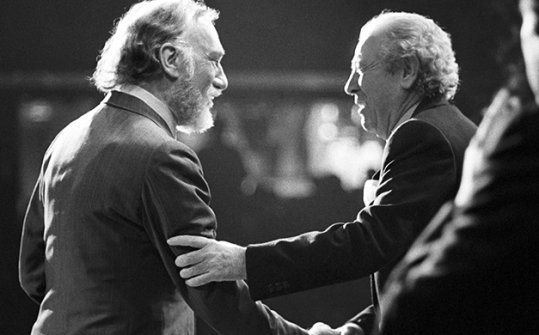Berlanga y Fernán Gómez, en diálogo (eBook)
The centenary of the birth of Luis García Berlanga (1921-2010) and Fernando Fernán Gómez (1921-2007) allows us to analyze their filmographies as directors in comparative terms. Renovators of Spanish cinema in the 1950s and mainly cultivators of comedy, both drew from the same sources of the Spanish cultural tradition - picaresque, sainete ... - and had in common the collaboration with prominent figures of Spanish literature and cinema from the second half of the twentieth century. Along with the influence of Italian neorealism in his films, this book studies their shared relationships with such prominent writers as Wenceslao Fernández Flórez, Enrique Jardiel Poncela, Miguel Mihura, Edgar Neville and Rafael Azcona, among others, as well as with various screenwriters and filmmakers - Florentino Soria, Pedro Beltrán, Jesús Franco, Juan Estelrich… - who worked or influenced his films. This essay also points to the rest of their work as creators, points out at each moment the socio-political and cinematographic contexts of their careers and notes the divergent points of their trajectories.
Manuel Hidalgo (Pamplona, 1953) is a writer, cultural and opinion journalist, critic and screenwriter. In 1981 he published Fernando Fernán Gómez (Huelva Ibero-American Film Festival) and “El último austrohúngaro. Conversaciones con Berlanga" (Anagrama), co-written with Juan Hernández Les, a book reissued in 2020 by Alianza in a greatly expanded version. He has also published books on Carlos Saura, Francisco Rabal and Luis Buñuel (" El banquete de los genios “, Peninsula, 2013 Among his six novels, it is worth highlighting “El pecador impecable” (Tusquets, 1986), “Azucena, que juega al tenis” (Mondadori, 1988), ”La infanta baila" (Plaza and Janés, 1997) and “Lo que al aire mueve “(Algaida, 2008, Logroño Award). He has written, among others, the scripts for ”El portero" (2000, nominated for a Goya for Best Adapted Screenplay), “Nubes de verano”(2004) and “Mujeres en el parque” (2007). Other books of his are "El Hombre Malo estaba allí ”(Aguilar, 2001) and “El lugar de uno mismo” (Alianza, 2017).
Summary
1 El encuentro de Esa pareja feliz
2 La inspiración del neorrealismo italiano
3 Florentino Soria, Ennio Flaiano y Cesare Zavattini
4 Fernández Flórez, Calabuch y El malvado Carabel
5 ¡Bienvenido, Mister Marshall! y Miguel Mihura
6 Otras comedias, otros comediógrafos
7 Solo para hombres y Ninette y un señor de Murcia
8 Edgar Neville, el gran amigo común
9 Enrique Jardiel Poncela, un referente
10 En la galaxia de La Codorniz
11 Salamanca y el Nuevo Cine Español
12 Rafael Azcona, el hombre clave
13 Plácido y El verdugo, un díptico magistral
14 Dos grandes películas: El extraño viaje y El mundo sigue
15 En compañía de Jesús Franco
16 La colaboración con el irrepetible Pedro Beltrán
17 Antes y después de la hora de la Transición
18 El camino de Juan Estelrich hasta El anacoreta
19 La escopeta nacional y la llegada de la modernidad
20 Moros y cristianos y El viaje a ninguna parte
21 Las últimas películas, García Sánchez y el final

